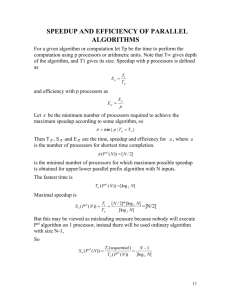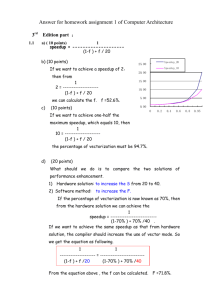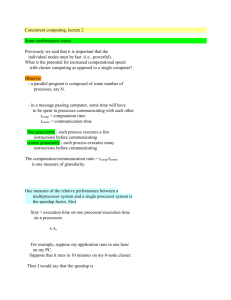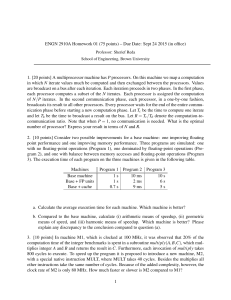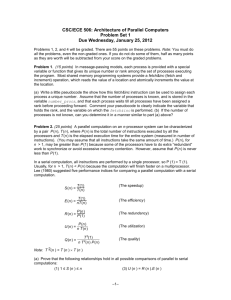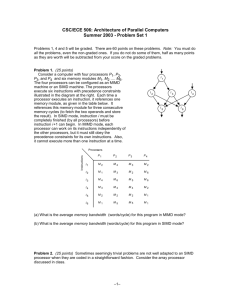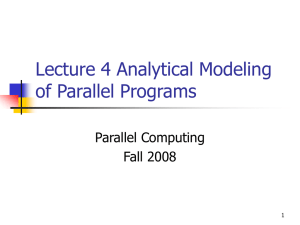speedup and efficiency of parallel algorithms
advertisement
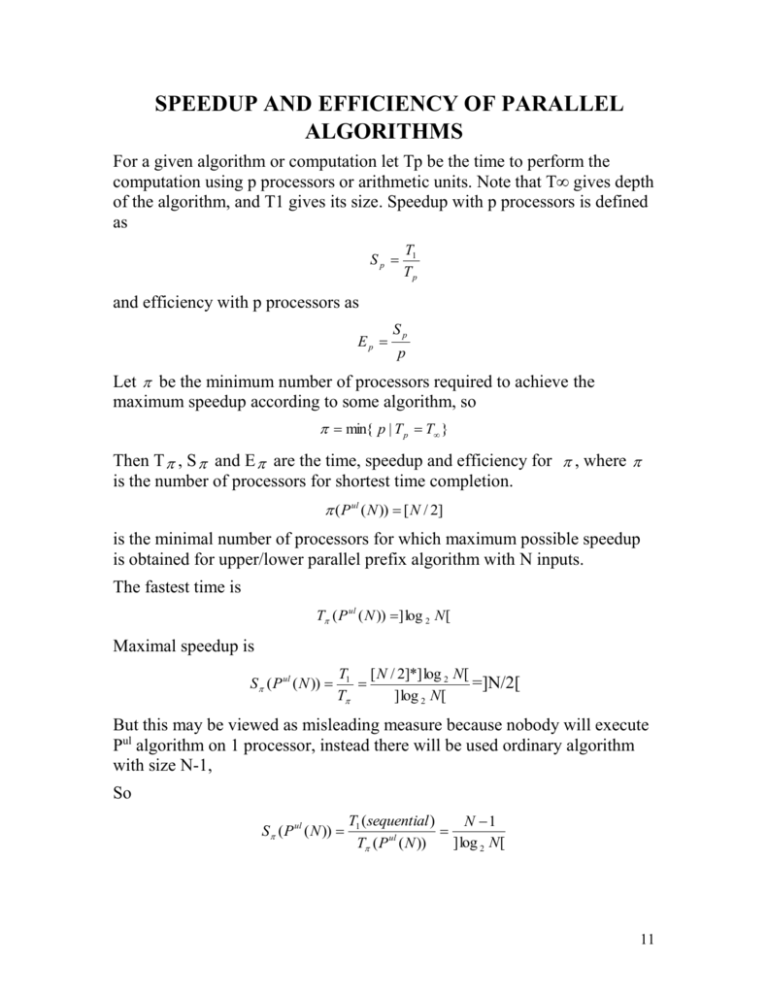
SPEEDUP AND EFFICIENCY OF PARALLEL
ALGORITHMS
For a given algorithm or computation let Tp be the time to perform the
computation using p processors or arithmetic units. Note that T∞ gives depth
of the algorithm, and T1 gives its size. Speedup with p processors is defined
as
Sp
T1
Tp
and efficiency with p processors as
Ep
Sp
p
Let be the minimum number of processors required to achieve the
maximum speedup according to some algorithm, so
min{ p | T p T }
Then T , S and E are the time, speedup and efficiency for , where
is the number of processors for shortest time completion.
( P ul ( N )) [ N / 2]
is the minimal number of processors for which maximum possible speedup
is obtained for upper/lower parallel prefix algorithm with N inputs.
The fastest time is
T ( P ul ( N )) ] log 2 N [
Maximal speedup is
S ( P ul ( N ))
T1 [ N / 2]*] log 2 N [
=]N/2[
T
] log 2 N [
But this may be viewed as misleading measure because nobody will execute
Pul algorithm on 1 processor, instead there will be used ordinary algorithm
with size N-1,
So
S ( P ul ( N ))
T1 (sequential )
N 1
ul
] log 2 N[
T ( P ( N ))
11
SPEEDUP AND EFFICIENCY OF PARALLEL
ALGORITHMS (CONT 1)
E ( P ul ( N ))
N 1
1
2
*
,N 4
] log 2 N [ [ N / 2] log 2 N
It is obvious that parallelism and speedup depends on the algorithm. But for
some cases there may be obtained bounds for parallelism, it is the case of
arithmetic expressions.
Lemma. For any number p of processors,
T p ( E ( N )) ] log 2 N [ ,
where N is number of atoms
Proof. Because there is a single result and all operators are binary, there can
be no more than 2 intermediate results at the previous to the last step of
computation, no more than 4 on the step prior to that, and so on. In general,
if there are k steps, there are no more than 2 k 1 intermediate values at step 1,
hence 2 k N , and the result follows (k gives number of steps for
calculation).
Previous lemma establishes lower bound, but really computations may
require more steps due to the presence of parenthesis and order imposed by
operators’ precedence rules.
For example, expression E(8)=A+B(CDE+F+G)+H, when evaluated from
left to right, will yield the tree with 7 levels. It may be optimized by usage of
associativity, commutativity and distributivity to the
E1(10)=((A+H)+(B*C)*(D*E))+(B*F+B*G)
having tree representation with 4 levels.
12
PERFORMANCE ISSUES
Factors influencing performance:
Hardware (fundamentals)
Architecture (both individual and system level)
Operating system (as extension to hardware)
Language (compiler and run-time libraries)
Program (structure and synchronization)
Algorithm (dependence graph)
AMDAHL’S LAW
Let P be the number of parallel processing units (processors, ALUs, stages
in pipelines)
Let T(P) be execution time with hardware parallelism P.
Let S be the time which is required to made sequential part of an algorithm
Let Q be the time which is required to make parallel part of the algorithm
sequentially.
Then
T(P)=S+Q/P
Let’s introduce
f
S
- fraction of serial work
S Q
Then
T(P)=f*T(1)+(1-f)*T(1)/P
Then speedup is
S ( P)
T (1)
1
T ( P) f (1 f ) / P
and the efficiency is
E ( P)
S ( P)
1
P
1 f ( P 1)
13
AVERAGE EXECUTION RATE
It is measured in operations/second (MFLOPS, MIPS).
If the sequential execution rate is Rs operations per second and we take
execution rate of fully parallelizable code as Rp=P*Rs, then the time to
execute amount of work W, of which fraction f is not parallelizable and a
fraction (1-f) is fully parallelizable is
Tw=fW/Rs +(1-f)W/Rp.
This means that the average execution rate in operations per second for the
work is
Ra=W/Tw= (f/Rs+(1-f)/Rp)-1
Thus, Ra is a weighted harmonic mean of Rs and Rp
It may be also written as
1/Ra=f/Rs+(1-f)/Rp
If g is a fraction of time spent running at rate Rs instead of fraction of work
done at this rate, then
Ra=gRs+(1-g)Rp
14
